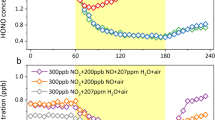Abstract
ONE of the more remarkable achievements of atmospheric chemistry is the identification by Crutzen1, in 1970, of nitric oxide (NO) as the main natural agent for the destruction of ozone produced photochemically in the stratosphere. The principal source of stratospheric NO is the reaction of excited oxygen atoms (O1D) with nitrous oxide (N2O)2, present as a normal constituent of the Earth's atmosphere. N2O was first observed, in 1938, by Adel3 in the absorption bands in the 7.8 µm region of the solar spectrum, but knowledge of its atmospheric life cycle is still very incomplete because of the few measurements available of its atmospheric concentration and limited information on atmospheric sources and sinks. The soil has been suggested as a major source of atmospheric N2O4 and the ocean has been proposed to act both as a source5 and as a sink6. The only sink so far positively established by atmospheric measurement lies in the stratosphere, being predominantly photodissociative in nature with an additional contribution from the chemical reaction with excited oxygen atoms4,7. We report here evidence for the existence of an appreciable, but unidentified, ground surface sink mechanism.
Similar content being viewed by others
References
Crutzen, P. J. Q. Jl R. met. Soc. 96, 320–325 (1970).
McElroy, M. B. & McConnell, J. C. J. atmos. Sci. 28, 1095 (1971).
Adel, A. Astrophys. J. 90, 627 (1939).
Shutz, K., Junge, C. E., Beck, R. & Albrecht, B. Tellus XXVI 4, 477–488 (1974).
Hahn, J. Tellus, XXVI 1–2, 160–168 (1974).
McElroy, M. B., Elkins, J. W., Wofsy, S. C. & Yung, Y. L. Rev. Geophys. Space Phys. 14, 143–150 (1976).
Nicolet, M. & Peetermans, W. Ann. Geophys. 28(4), 751–761 (1972).
Wentworth, W. E., Chan, E. & Freeman, R. J. chem. Phys. 55, 2075 (1971).
Ehhalt, D. H., Gravenhorst, G. & Pollock, W. Paper given to Joint Symposium on Atmospheric Ozone, Dresden (1976).
Rasmussen, R. A., Krasnec, J. & Pierotti, D. Geophys. Res. Letters 3, 615 (1976).
Pierotti, D. & Rasmussen, R. A. Geophys. Res. Lett. 3, 365 (1976).
Garland, J. A. Proc. R. Soc. A. (in the press).
Garland, J. A. & Penkett, S. A. Atmos. Env. 10, 1127 (1976).
Atkins, D. H. F., Cox, R. A. & Eggleton, A. E. J. Nature 235, 372 (1972).
Matsubara, T. & Mori, T. J. Biochem. 64, 863–867 (1968).
Blackmer, A. M. & Bremner, J. M. Geophys. Res. Lett. 3, 739–742 (1976).
Cox, R. A. & Penkett, S. A. Atmos. Env. 6, 365 (1972).
Galbally, I. E. Q. Jl R. met. Soc. 97, 18 (1971).
Brice, K. A. & Penkett, S. A. Harwell Report No. AERE 8569 (1977).
Johnston, H. S. & Selwyn, A. Geophys. Res. Lett. 2, 549 (1975).
Author information
Authors and Affiliations
Rights and permissions
About this article
Cite this article
BRICE, K., EGGLETON, A. & PENKETT, S. An important ground surface sink for atmospheric nitrous oxide. Nature 268, 127–129 (1977). https://doi.org/10.1038/268127a0
Received:
Accepted:
Issue Date:
DOI: https://doi.org/10.1038/268127a0
- Springer Nature Limited





